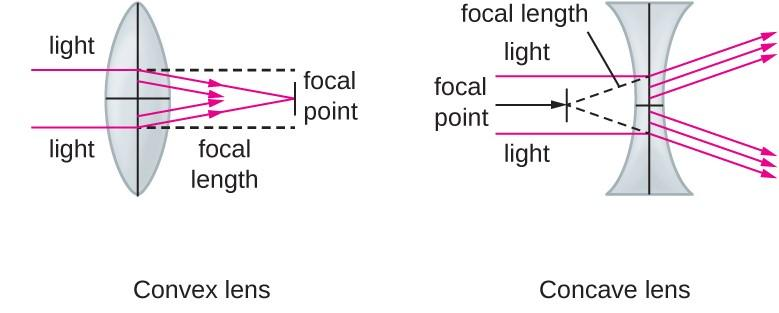
Which type of lens has negative power?
A) Convex lens
B) Concave lens
C) Both A and B
D) None
Answer
143.4k+ views
Hint: Reciprocal of focal length is considered as power of a lens. To the numerical value of power we assign negative and positive signs as per sign convention. If the image resolves on the right side of the principal axis, the power is positive and if the image resolves on the left side of the principal axis, the power is positive.
Formula used:
${P_L} = \dfrac{1}{f}$
Where ${P_L}$ is the power of the lens.
$f$ is the focal length
Complete step by step answer:
Power of a lens is the ability to deviate the path of rays of light passing through it. If the lens converges the rays, power is positive and if the lens diverges the rays, the power is negative.
The converging and diverging abilities of both types of lenses is shown below,

So we can now have an idea that a convex lens has positive power and a concave lens has negative power.
So, The correct answer is (B), concave lens.
Additional Information:
We can also solve this question by considering the sign convention of geometric optics.
By sign convention, any distance measured from the principal of the lens in the left direction is negative and any distance measured from the right of the length is positive.
For a convex lens, focal length $(f)$ is positive and for a concave lens, the value of $f$ is negative.
So by assigning signs to focal length in the power formula $({P_L} = \dfrac{1}{f})$ we get negative value for concave lens and positive value for convex lens.
Note: Never mix up sign conventions in optics, because examiners tend to put the same numerical options with different signs to confuse a student. Quick trick is, anything up or right from the principal is positive and anything left or down from the principal is negative.
Formula used:
${P_L} = \dfrac{1}{f}$
Where ${P_L}$ is the power of the lens.
$f$ is the focal length
Complete step by step answer:
Power of a lens is the ability to deviate the path of rays of light passing through it. If the lens converges the rays, power is positive and if the lens diverges the rays, the power is negative.
The converging and diverging abilities of both types of lenses is shown below,

So we can now have an idea that a convex lens has positive power and a concave lens has negative power.
So, The correct answer is (B), concave lens.
Additional Information:
We can also solve this question by considering the sign convention of geometric optics.
By sign convention, any distance measured from the principal of the lens in the left direction is negative and any distance measured from the right of the length is positive.
For a convex lens, focal length $(f)$ is positive and for a concave lens, the value of $f$ is negative.
So by assigning signs to focal length in the power formula $({P_L} = \dfrac{1}{f})$ we get negative value for concave lens and positive value for convex lens.
Note: Never mix up sign conventions in optics, because examiners tend to put the same numerical options with different signs to confuse a student. Quick trick is, anything up or right from the principal is positive and anything left or down from the principal is negative.
Recently Updated Pages
How to find Oxidation Number - Important Concepts for JEE

How Electromagnetic Waves are Formed - Important Concepts for JEE

Electrical Resistance - Important Concepts and Tips for JEE

Average Atomic Mass - Important Concepts and Tips for JEE

Chemical Equation - Important Concepts and Tips for JEE

Concept of CP and CV of Gas - Important Concepts and Tips for JEE

Trending doubts
JEE Main 2025 Session 2: Application Form (Out), Exam Dates (Released), Eligibility, & More

JEE Main Exam Marking Scheme: Detailed Breakdown of Marks and Negative Marking

JEE Main 2025: Derivation of Equation of Trajectory in Physics

Electric Field Due to Uniformly Charged Ring for JEE Main 2025 - Formula and Derivation

Degree of Dissociation and Its Formula With Solved Example for JEE

Physics Average Value and RMS Value JEE Main 2025

Other Pages
Units and Measurements Class 11 Notes: CBSE Physics Chapter 1

JEE Advanced Marks vs Ranks 2025: Understanding Category-wise Qualifying Marks and Previous Year Cut-offs

NCERT Solutions for Class 11 Physics Chapter 1 Units and Measurements

Motion in a Straight Line Class 11 Notes: CBSE Physics Chapter 2

JEE Advanced 2025: Dates, Registration, Syllabus, Eligibility Criteria and More

JEE Advanced Weightage 2025 Chapter-Wise for Physics, Maths and Chemistry




